Patterning Train Cars
The objective of this lesson is to have children practice making patterns and recognizing patterns

Connect
Tell the children that they are going to explore patterns.
Ask the following questions to help them connect with the lesson:
- What are patterns?
- What are some examples of patterns?
· Point out some patterns around the classroom.Tell the children that they are going to become a “living pattern.”
Ask them to stand in a circle. Tell every other child that they should say
“awesome” when you point to them and tell the other children that they should say “patterns.”
• Go around the circle pointing to each child. It should sound like, “awesome, patterns, awesome, patterns.”
• Explain that this is a pattern and that parts of a pattern repeat, which means that once they understand the repeating order, they will know what comes next
Construct
Tell the children that patterns can also consist of shapes and colors, and that they are going to make patterns on train cars.
Show the inspiration photos, pointing out the different kinds of patterns.
- Explain that some use bricks built on top of one another and other patterns cover the train car.Ask each child to pick one of the inspiration photos to replicate. Encourage them to use different colors or to create an entirely new pattern. Remind them that each of
their patterns should repeat. If necessary, help them sort the bricks they need.Once the children have finished building, ask them to take turns saying their patterns out loud (e.g., “orange, yellow, orange yellow”).



Contemplate
Encourage the children to discuss their patterns.
Consider asking questions like:
- How many colors are in your pattern?
- How many times does your pattern repeat?
Continue
Encourage the children to create their own patterns.
Help them decide on the colors and shapes they will use, gather the bricks, and build their patterns. Remind them that their bricks must repeat at least once in order
for it to be a pattern.If they are ready, ask them to work together to create a pattern using multiple train cars.
- Build a simple pattern on the first train car, and another simple pattern on the second car.
- Repeat the pattern from the first car on the third car, and the pattern from the
second car on the fourth car, etc. (see the appendix for an example).
Did you notice?
Observing the following skills can help you monitor whether the children are developing the necessary competencies in math.
- Using mathematical terms, such as positional language and color names
- Categorizing by one or more attributes and comparing two or more objects
- Recognizing and creating increasingly complex patterns
Ondersteuning voor de leraar
Children will:
- Sort by size and color
- Practice making patterns
- Recognize patterns
For up to 6 children
The Mathematics guidelines from the National Association for the Education of Young Children (NAEYC) and HeadStart have been used to develop the Math Train lessons. Please refer to the learning grid for an overview of the learning values referenced throughout this Teacher Guide.
The learning goals listed at the end of each lesson can be used to determine whether or not each child is developing the relevant early math skills. These bullet points target specific skills or pieces of information that are practiced or presented during each lesson.